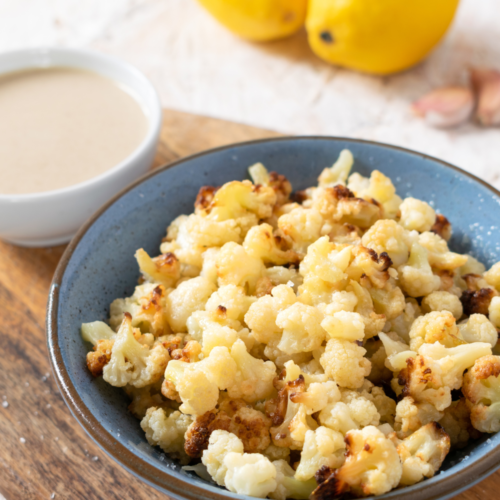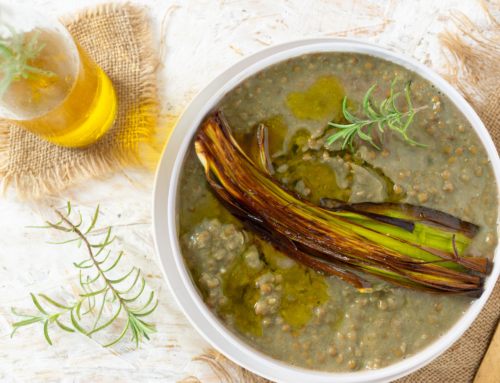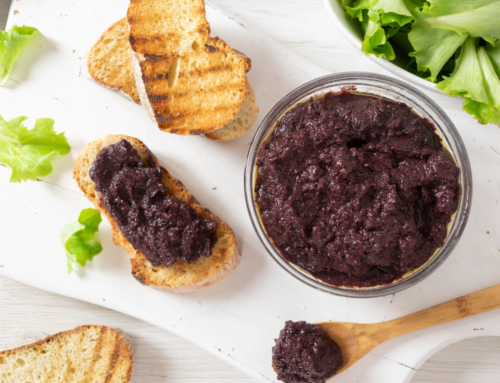Arnabit with tarator is the Arabic name for cauliflower with tahini or lemon garlic sauce. Now, cauliflower is not as popular as broccoli. However, this shy vegetable shines when it’s done the way we prepare it in this fried cauliflower recipe. It’s golden brown and crispy on the outside and tender and juicy on the inside. The contrast in textures makes it just that little bit extra delicious. The secret to this Lebanese cauliflower recipe is boiling the cauliflower before frying it. Many Lebanese restaurants just immediately fry the vegetable, which makes it lose its sweet and soft interior taste.
Tarator or tahini sauce is very common in Lebanon, as many locals like it. It is used with fish, falafel sandwiches, and meat shawarma as well. It is light and has a delicious taste.

In Lebanese cuisine, arnabit with tarator is served as a mezze or appetizer. However, our family regularly eats it as a main dish for lunch, along with some homemade fries, falafel, and a side salad. The best experience is putting a small fried cauliflower floret in a piece of pita bread and then dipping it in tarator sauce. It is so good! I hope you try this Lebanese cauliflower recipe for yourself.
Lebanese Cauliflower Notes
- It’s really important that you pat the cauliflower dry before frying it, as this will make it brown faster.
FAQs
What is arnabit?
Arnabit (also spelled arnabeet) means cauliflower in Arabic so this is essentially an Arabic cauliflower recipe. In this instance, we are pairing arnabit with tarator or tahini sauce. Arnabit or arnabeet mekle (also spelled mekleh) means fried cauliflower.
How do you serve Lebanese cauliflower tahini?
Here are some ways to serve Lebanese fried cauliflower:
- Enjoy it as an appetizer or on a mezze platter with some fresh lemon wedges to squeeze on top.
- Make a Lebanese cauliflower salad and serve it over popular Lebanese salads like fattoush or tabbouleh.
- Serve it as a side dish with a main meal like grilled chicken, fish, or lamb chops.
- Do as my family does and serve it as a main meal with homemade fries, falafel, and a side salad.
- Enjoy it for lunch in pita bread or a wrap with your favorite salad toppings.
- Serve it with a different sauce, like hummus, harissa, or tzatziki.
- Add a garnish of finely chopped fresh mint leaves, fresh parsley, fresh cilantro, sumac, or a sprinkle of paprika.
How do you store fried cauliflower bites?
It’s best to serve the fried cauliflower florets immediately, as it does get soft and mushy once it cools. However, if you have leftover homemade tahini, it can be stored in an airtight container or jar in the fridge for up to one month.
Can I roast the Lebanese cauliflower instead?
Absolutely. If you’d prefer roasted cauliflower, spread the florets out on a baking sheet and drizzle them with olive oil. You can also season with salt, freshly ground black pepper, and ground cumin. Then roast them in a 450-degree oven for about 25 minutes, until their soft and golden. To add more color, place them under the broiler for three to four minutes.
You can also make air-fried cauliflower if you prefer. However, you’ll need to do it in small batches depending on your air fryer’s size as you don’t want to overcrowd the basket. Air fry the cauliflower florets at 400 degrees for 20 to 25 minutes, turning halfway.
Is this Middle Eastern cauliflower recipe vegan and gluten-free?
Yes, as is, this fried cauliflower recipe is both vegan and gluten-free.

Lebanese Fried Cauliflower with Tahini (Arnabit with Tarator)
Ingredients
For the Cauliflower
- 1 medium cauliflower, washed and cut into small florets
- vegetable oil or olive oil for frying
For the Tahini Sauce
- ⅓ cup tahini
- ¼ cup water
- ¼ cup freshly squeezed lemon juice
- 1 tbsp extra virgin olive oil
- ½ tsp salt
- 1 small clove garlic, peeled and minced
Instructions
- Bring a pot of water to a boil, then cook the cauliflower florets for 10 to 12 minutes until they are tender. Thoroughly drain the cauliflower and pat it dry with paper towels.
- Make the sauce while the cauliflower boils. Put the tahini in a small bowl, then slowly add the water, stirring constantly. When the water and tahini are well-blended, add the lemon juice, oil, salt, and garlic, and stir until the ingredients are well combined.
- Pour 1 inch of the vegetable oil into a medium pot, then heat the oil over high heat until it reaches 350 degrees fahrenheit. Fry the florets for 3 to 5 minutes on each side, until they become light golden brown. Remove them with a slotted spoon and place them on a paper towel-lined plate.
- You can spoon the sauce over the cauliflower, or serve it on the side for dipping.





